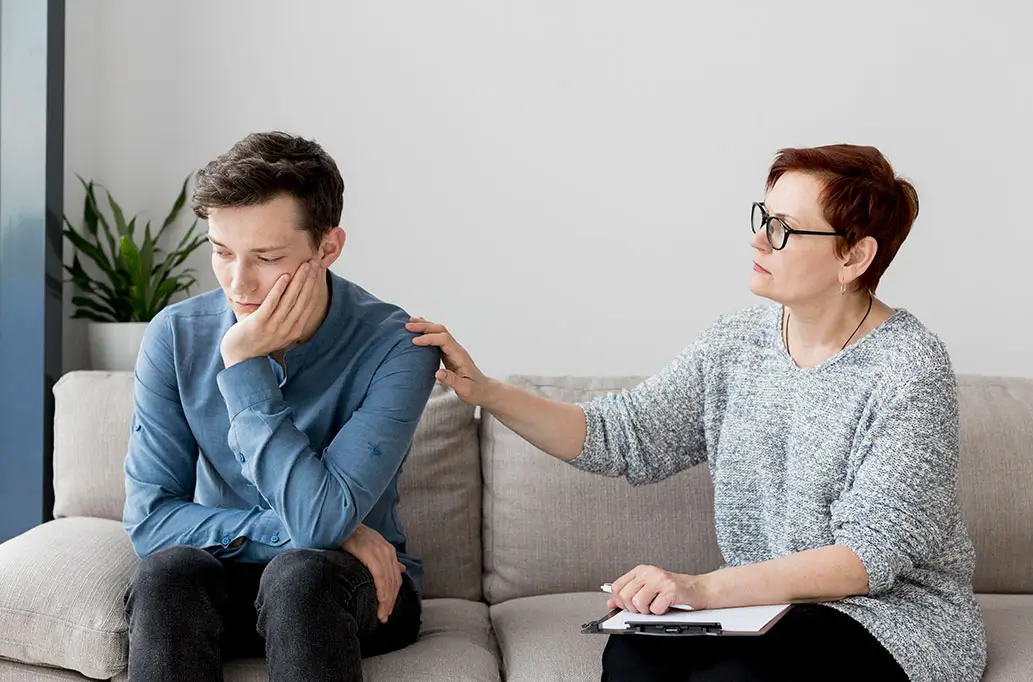ECT for PTSD is effective when people go through really tough times and experience an event that makes them numb, such as a scary car crash or being in a loud war. They might struggle with their feelings, especially if it’s something called Post-Traumatic Stress Disorder (PTSD). These changes help to streamline the sentence and improve overall clarity.
This can make the brain feel not-so-good. That’s when Electroconvulsive Therapy (ECT) can be a helpful way to make things better.
In this blog, we’re taking a closer look at ECT and how it’s changing the game for people with PTSD. We’ll discuss how ECT is used to help, assess its effectiveness, and identify any important considerations. Stick around as we explore who can give ECT a try and who might need a different path. So let’s begin with exploring the transformative role of ECT for PTSD. Let’s understand how this therapy is making a real difference in the world of mental health.
Living with PTSD is making you feel isolated?
With specialized therapies and compassionate support, a brighter future is possible.
Research Findings on the Effectiveness of ECT for PTSD
Some people with PTSD easily find help in a treatment called electroconvulsive therapy (ECT), according to several studies.
PTSD is a mental health issue that occurs after experiencing a scary event like an accident or a human. In the U.S., around 6.8% of adults and 5% of teenagers deal with it, as shared by the National Institute of Mental Health.
Common treatments for PTSD include taking medicine and therapies, which are proven effective for many. Now, there’s electroconvulsive therapy (ECT) which can also help with PTSD symptoms, especially for those who didn’t get better with the medicines and therapies treatments. PTSD is prevalent cross-nationally, with large data surveys from the World Health Organization finding the lifetime prevalence to be 3.9%, of which half reported persistent symptoms.
A randomized trial conducted by ScienceDirect shows how well ECT for PTSD works, especially when someone has a high level of depression.
So, Let’s first understand what is PTSD, ECT, and ECT for PTSD.
What is PTSD?
PTSD is a mental health issue that happens after a really scary experience, whether you went through it or saw it happen. It can make you have bad memories, nightmares, and strong anxiety, causing thoughts about the event that you can’t shake off.
Even though some people naturally start feeling better after tough times, if these feelings stick around for a long time and mess with your everyday life, it might be PTSD. It’s important to reach out for help and treatment early because it can make these symptoms lighter and help you feel better overall.
What is ECT?
Electroconvulsive therapy (ECT) is a medical procedure done while you’re asleep. They use small electric currents to cause a brief seizure in the brain. This process can bring fast relief to some mental health issues by changing the brain’s chemistry.
ECT is considered when other treatments don’t work, and it can be successful if the full treatment is completed. But it might not help everyone.
In the past, ECT had a bad reputation because it used to give strong shocks without making people asleep, causing memory loss and other serious problems. Nowadays, it’s done under anesthesia to avoid those issues.
How is ECT Used for PTSD Treatment?
Electroconvulsive Therapy (ECT) is a mental health treatment where doctors use a small amount of electricity to cause a seizure in the brain. You get anesthesia to sleep, your muscles relax, and then doctors put electrodes on your head. After a quick electrical pulse, it causes a short seizure, lasting about 5 to 10 minutes.
Doctors often use ECT for PTSD and severe depression which doesn’t get better with other treatments. According to the American Psychiatric Association, it helps about 80% of people with severe depression.
Some research also suggests that ECT is effective for PTSD at different times. However, since ECT isn’t a common way to treat PTSD, there’s not a lot of evidence on how well it works for this condition.
Effectiveness of ECT for PTSD
Most studies about electroconvulsive therapy (ECT) mainly look at how it helps with very severe depression. However, a couple of small studies hint that it might also be helpful for PTSD and depression happening together.
In a 2021 study, combining ECT with memory reactivation improved PTSD symptoms immediately and sustained these benefits at the 3-month mark. Another case study that year highlighted significant improvement in nightmares and overall symptoms in a combat veteran after six ECT sessions.
A 2023 review of five studies found ECT notably reduced intrusion, avoidance, and hyperarousal in individuals with PTSD. Despite positive outcomes, more research is needed to fully understand ACT’s impact on PTSD.
Types of ECT to Treat PTSD

There are two main types of Electroconvulsive Therapy (ECT) commonly used for treating PTSD:
- Unilateral ECT: They place electrodes on one side of your head, focusing on a specific part of the brain. People often like this because it might reduce memory side effects while effectively treating PTSD symptoms.
- Bifrontal ECT: In this type, electrodes go on both sides of your head, targeting the front part of the brain. Bifrontal ECT aims to be good at treating PTSD symptoms while trying to lower memory-related side effects linked to broader stimulation.
Both types use controlled electric currents to create a therapeutic seizure. The choice between them depends on things like how bad your symptoms are, your medical history, and finding the right balance between how well the treatment works and any possible side effects. Talk to your healthcare team to figure out what’s best for you.
The Downside of Using ECT to Treat PTSD
ECT helps with mental health problems quickly. It works faster than medicines and talking therapies. People usually feel better after just a few sessions of ECT, which is faster than other treatments like medications and therapy.
After ECT, people might have temporary side effects like-
- Headache
- Fatigue
- Nausea
- Confusion
- Memory loss
In a few cases, people might experience these rare side effects like –
- Prolonged seizures
- Changes in blood pressure
- Changes in heart rate
- Respiratory symptoms
Usually, these effects are temporary and don’t last long after treatment.
ECT for PTSD: Who Should Avoid It?
ECT is generally a safe and effective option for severe, treatment-resistant mental health conditions. However, it may not be suitable for individuals with certain health conditions, such as:
Pheochromocytoma
Increased intracranial pressure
Heart conduction disorders
- Brain aneurysm
- High-risk pregnancy
If you have PTSD and other mentioned conditions, your doctor will probably discuss with you the possible risks and benefits of using ECT for PTSD and your situation before deciding on the treatment.
Can ECT Trigger PTSD?
Post-traumatic stress disorder (PTSD) can come from different tough experiences, but there’s no proof that Electroconvulsive Therapy (ECT) causes PTSD or is a side effect. Recent studies even say the opposite – that ECT might be a helpful treatment for people dealing with PTSD symptoms.
It’s important to understand that although PTSD can happen for various reasons, it doesn’t seem like ECT adds to it. Always talk to your healthcare provider for advice that fits your situation.
Connection Between PTSD and Excessive Sleeping
If you have PTSD, it can spoil your sleep schedule. It might make you feel tired a lot, and you could end up sleeping too much. Sometimes, people with PTSD might have a condition called hypersomnia, making them feel sleepy even when they get enough sleep. So, it’s like having a bit of a tough time with sleep because of PTSD.
Common Sleep Issues in PTSD
PTSD has a strong connection with sleep and hence can cause various issues. Beyond Excessive sleeping, it comes with other issues like-
- Confusional Arousals
- Frequent Night Awakenings
- Insomnia
- Nightmares
- Night Terrors
- Obstructive Sleep Apnea
- Periodic Limb Movements
- REM-Related Sleep Disorders
- Restless Leg Syndrome
- Sleep Apnea
- Sleep Talking
- Sleepwalking
- Sleep Paralysis
Facing common sleep issues is something many individuals dealing with PTSD might experience. It’s really important to understand and deal with these problems to make sure that sleep quality gets better for them.
Tired of fighting addiction and mental health struggles?
Ignoring both deepens the struggle. Our holistic approach—detox, therapy, and medication-assisted treatment—can help you heal. Take the first step today.
FAQs: ECT for PTSD
Can ECT effectively treat PTSD?
Yes, research says ECT can help people with both PTSD and depression. It’s shown to make the symptoms better and bring relief to those dealing with these tough conditions.
Who should avoid ECT treatment?
Individuals with heart conditions or those who cannot tolerate short-acting sedatives or muscle relaxers are not suitable candidates for ECT treatments.
Can ECT cause lasting damage to the brain?
For most people getting ECT, there’s no sign of lasting damage to the brain.
What is the success rate of ECT?
Electroconvulsive Therapy is a successful medical treatment, helping around 80-85 percent of patients who undergo it.
The Bottom Line on ECT for PTSD
Living with PTSD can significantly impact your daily life, leading to feelings of fear, overwhelming burdens, and persistent negative thoughts. However, finding effective treatment options can greatly alleviate these challenges. While medication and various therapies are often beneficial, if these methods prove ineffective, electroconvulsive therapy (ECT) may be considered as an alternative.
If you’re grappling with PTSD and seeking further insight into potential treatments, it’s crucial to consult with a healthcare professional or mental health specialist. They can assist you in determining the most suitable approach tailored to your individual needs, including the possibility of incorporating ECT into your treatment plan.
At Avisa, our primary objective is to deliver comprehensive and compassionate care that addresses the intricate nature of mental health and substance use disorders. We are dedicated to supporting individuals in achieving long-term recovery and enhancing their overall quality of life. With a collaborative community of medical and clinical experts, our program continually evolves to integrate the latest research findings and evidence-based practices.
Each person in our program receives a personalized treatment plan encompassing a variety of therapeutic modalities. We recognize the importance of addressing the holistic needs of individuals – emotional, mental, physical, and spiritual – in their journey toward healing. Moreover, we are committed to dismantling systemic barriers that hinder marginalized populations from accessing quality care.
We extend a warm invitation for you to embark on your healing journey with us at Avisa.










